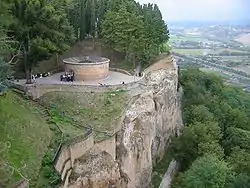Pozzo di San Patrizio
The Pozzo di San Patrizio (English: "St. Patrick's Well") is a historic well in Orvieto, Umbria, central Italy. It was built by the architect-engineer Antonio da Sangallo the Younger of Florence, between 1527 and 1537, at the behest of Pope Clement VII who had taken refuge at Orvieto during the sack of Rome in 1527 by the Holy Roman Emperor Charles V, and feared that the city's water supply would be insufficient in the event of a siege. The well was completed in 1537 during the papacy of Pope Paul III.

The name was inspired by medieval legends that St. Patrick's Purgatory in Ireland gave access down to Purgatory, indicating something very deep.
The architect-engineer Antonio da Sangallo the Younger surrounded the central well shaft with two helical ramps in a double helix, accessed by two doors, which allowed mules to carry empty and full water vessels separately in downward and upward directions without obstruction. The cylindrical well is 53.15 metres (174.4 ft) deep with a base diameter of 13 metres (43 ft). There are 248 steps and 70 windows provide illumination.[1]
A Latin inscription on the well states QUOD NATURA MUNIMENTO INVIDERAT INDUSTRIA ADIECIT 'what nature stinted for provision, industry has supplied'.
Gallery
 The Pozzo di San Patrizio, a well built for Rome commissioned by Pope Clement VII
The Pozzo di San Patrizio, a well built for Rome commissioned by Pope Clement VII Interior view, showing the double helix staircase
Interior view, showing the double helix staircase
Notes
- Dal sito del Comune di Orvieto: Orvieto nella storia: Orvieto sotterranea – Pozzo di San Patrizio, retrieved 2008-10-21
References
- Review of Pozzo di San Patrizio (St. Patrick's Well) at Frommers (tourism site)